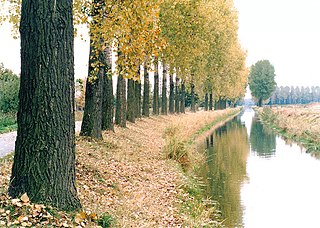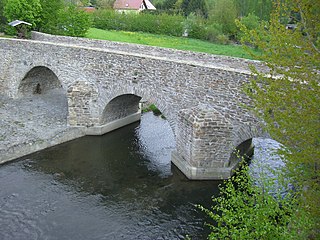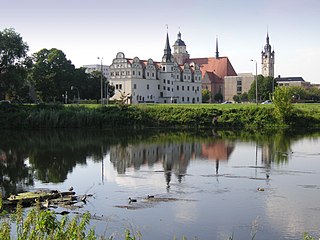
The Elbe is one of the major rivers of Central Europe. It rises in the Krkonoše Mountains of the northern Czech Republic before traversing much of Bohemia, then Germany and flowing into the North Sea at Cuxhaven, 110 kilometres northwest of Hamburg. Its total length is 1,094 km (680 mi).

The Aller is a 215-kilometre (134 mi) long river in the states of Saxony-Anhalt and Lower Saxony in Germany. It is a right-hand, and hence eastern, tributary of the Weser and is also its largest tributary. Its last 117 kilometres (73 mi) form the Lower Aller federal waterway (Bundeswasserstraße). The Aller was extensively straightened, widened and, in places, dyked, during the 1960s to provide flood control of the river. In a 20-kilometre (12 mi) long section near Gifhorn, the river meanders in its natural river bed.

The Havel is a river in north-eastern Germany, flowing through the German states of Mecklenburg-Vorpommern, Brandenburg, Berlin and Saxony-Anhalt. It is a right tributary of the Elbe and 325 kilometres (202 mi) long. However, the direct distance from its source to its mouth is only 94 kilometres (58 mi).

The Saale, also known as the Saxon Saale and Thuringian Saale, is a river in Germany and a left-bank tributary of the Elbe. It is not to be confused with the smaller Franconian Saale, a right-bank tributary of the Main, or the Saale in Lower Saxony, a tributary of the Leine.

The Mulde is a river in Saxony and Saxony-Anhalt, Germany. It is a left tributary of the Elbe and is 124 kilometres (77 mi) long.
A reaction ferry is a cable ferry that uses the reaction of the current of a river against a fixed tether to propel the vessel across the water. Such ferries operate faster and more effectively in rivers with strong currents.

The Freiberger Mulde is the right-hand, 124-kilometre-long (77 mi) headstream of the river Mulde, whose catchment covers an area of 2,981 km2 (1,151 sq mi) in the Czech Republic and Germany in central Saxony. It has a volumetric flow of 35.3 m3/s (1,250 cu ft/s) which is greater than that of the other headstream, the Zwickauer Mulde who flow is about 26.4 m3/s (930 cu ft/s), which is nevertheless the longer stream.

The White Elster is a 257-kilometre (160 mi) long river in central Europe, right tributary of the Saale. Its source is in the westernmost part of the Czech Republic, near Aš. After a few kilometres, it flows into eastern Germany where it cuts through the Vogtland in a "deep and picturesque valley". In Germany it flows through the states of Saxony, Thuringia and Saxony-Anhalt. The White Elster flows through the cities of Plauen, Greiz, Gera, Zeitz, Pegau and Leipzig, and into the river Saale in Halle.

The Black Elster or Schwarze Elster is a 179-kilometre (111 mi) long river in eastern Germany, in the states Saxony, Brandenburg and Saxony-Anhalt, right tributary of the Elbe. Its source is in the Upper Lusatia region, near Elstra.

Old Saxony is the original homeland of the Saxons in the northwest corner of modern Germany and roughly corresponds today to the modern German state of Lower Saxony, Westphalia, Nordalbingia and western Saxony-Anhalt.

The Dresden Elbe Valley is a cultural landscape and former World Heritage Site stretching along the Elbe river in Dresden, the state capital of Saxony, Germany. The valley, extending for some 20 kilometres (12 mi) and passing through the Dresden Basin, is one of two major cultural landscapes built up over the centuries along the Central European river Elbe, along with the Dessau-Wörlitz Garden Realm downstream.

Dessau-Roßlau is a kreisfreie Stadt in the German state of Saxony-Anhalt. It is situated at the confluence of the rivers Elbe and Mulde. The town was formed by merger of the towns of Dessau and Roßlau in the course of the "Kreisreform Sachsen-Anhalt" (Sachsen-Ahalt Regional Boundary Reforms) on 1 July 2007. The reform involved a reduction in the number of rural districts in Sachsen-Anhalt from 21 to 11 and reflected an expected continuation of the significant population decline being experienced.

Saxony (Sachsen) is a region for quality wine in Germany located in the German federal state of Saxony. The region is sometimes referred to colloquially as the Elbtal. The wine region covers 462 hectares, which makes it Germany's third smallest region, just ahead of Mittelrhein and Hessische Bergstraße in size. It is situated along the Elbe river from the Pillnitz section of Dresden to the village of Diesbar-Seußlitz located north of Meissen. Together with the Saale-Unstrut wine region, Saxony is one of the northernmost wine regions in Europe and are the only two of Germany's 13 wine regions that are located in the former East Germany. After German reunification in 1990, the vineyard surface was expanded from 200 to 450 hectares with European Union subsidies, but in recent years the vineyard area has decreased.

Seeve is a river of Lower Saxony, Germany, a tributary of the Elbe. It is approximately 40 km (25 mi) long.

The Polenz is the right-hand, smaller headstream of the Lachsbach in the German state of Saxony. Its lower course flows through the western Elbe Sandstone Mountains in a canyon-like valley.

The Sebnitz is the left, larger headstream of the Lachsbach and runs through both the Czech Republic as well as the German Free State of Saxony. The upper section in the Czech Republic is known as Vilémovský potok in Czech and Wölmsdorfer Bach in German.

The Niederelbe is a 108 kilometers long section of the river Elbe, from western Hamburg downstream to its mouth into the North Sea near Cuxhaven. Starting at Mühlenberger Loch near Finkenwerder, Hamburg, it gradually widens from 2 km (1.2 mi) to 18 km (11 mi). Once passing the Hamburg state border, the Niederelbe also forms the border between the states of Lower Saxony and Schleswig-Holstein.

The Schwinge is river of Lower Saxony, Germany, a left tributary of the Elbe.

The Mecklenburg Elbe Valley Nature Park is part of the UNESCO biosphere reserve of Elbe River Landscape, which is over 400 river kilometres long and which runs through the five German states of Saxony-Anhalt, Brandenburg, Lower Saxony, Mecklenburg-Vorpommern and Schleswig-Holstein. It lies in the district of Ludwigslust-Parchim in Mecklenburg-Vorpommern. The nature park was called into existence in 1990 and legally established by act of state in 1998. It has an area of 426 km2 (164 sq mi).


















